Lisa Niver's Blog: We Said Go Travel, page 302
August 4, 2015
Wharton Business Magazine: Putting People Into Social Media Strategy
 Thank you to Wharton Business Magazine for publishing my article about Social Media and Travel.
Thank you to Wharton Business Magazine for publishing my article about Social Media and Travel.Putting People Into Social Media Strategy
After working on cruise ships for almost seven years, it was time to return to America and “real life.” I could have lived anywhere. I chose to live in Los Angeles because of my connections. I went to high school there, my parents are there, I love the weather. My dad has always said, “It is not what you know but who you know.” It turns out that advice works for picking where to live, what to do—and how to use social media.

Social media has saturated all the strands of our existence over the last 11 years. It is now part of our lexicon. We say, “Let me Google that.” We see television shows promoting hashtags at the bottom of the screen begging for engagement. Given the omnipresence of the tools of technology, brands need to be clear on how to best engage their consumers.
That’s a big “how.” Should brands focus on search engine marketing and optimization? Email? Definitely social media, right? Perhaps not, says Nate Elliot, vice president and principal analyst at Forrester. “Social media is not properly understood or measured. Social in comparison to search is less useful and generates less revenue. Excusing social as a young channel doesn’t make sense anymore,” he said.
Why? Social media is too big now to get wrong.
According to Elliot, almost 100 percent of marketers used social media last year and $7.3 billion was spent on social media in the U.S. He projects that number will grow to $9.7 billion this year, with 83 percent of social marketing spending goes toward ads (as opposed to agency fees and other costs).
Elliot states that social media is nowhere near realizing its potential. Marketers and brands include their top fans as ambassadors and harness social media word-of-mouth to share information about new items, sales and extra options. Brands need to understand when and how their customers are engaging and if social media is important to them. Determining your objectives is the first and most important step. Are you trying to create awareness? Increase sales? Engender loyalty? Each of these goals will mean you need a different strategy to achieve them. Only after you have assessed your assets, strengths, objectives and strategy can you turn to technology.
Starting with picking a social media channel is “asking the wrong question first,” Elliott told me. “It is not about technology and channels, it is about building relationships with people. Social was supposed to be about interaction, not about buying ads on Twitter chats.”
After interviewing Elliott, I was able to speak in person with Wheels Up CEO Kenny Dichter and on the phone with serial entrepreneur, J.R. Johnson. Both of these men exemplify what I learned at home and what Elliott has been researching. Building relationships is the most important thing to focus on to achieve business goals.

Wheels Up was featured in theEntourage movie, just as his previous company, Marquis Jet, was seen in the Entourage television show due to Dichter’s close friendship with the production team. Dichter shared that a key to his success comes from “hiring passionate talented people that are smarter than you.” But a closer look reveals that many on his team have been with him for decades and have rejoined in several companies due to their relationships with him and others on his team.
The way Wheels Up shares in social media is an extension of his personal philosophy to care about people and to build community. As most people are on the ground more than flying in the air, they have created Wheels Down events so that some of the #WheelsUp8760 experience (based on the number of hours in a year) can be continued together.
His choice to partner with Triple Crown winner American Pharaoh was based on evaluating risk and reward and years of experience. He recommends that all marketing directors “leave some opportunistic dollars in the budget so when a good idea appears you can take advantage in the moment.” Due to Dichter’s vast network and thriving relationships, he got a call at 6:30am one morning that led to the latest media partnership that has been well worth its investment.
How can your brand leverage relationships to thrive among social strands and styles? J.R. Johnson is a veteran of the travel industry who founded the websites Virtual Tourist, Lunch and Trippy, the latter which was listed in Business Insider May 2015 as one of the “25 hot Los Angeles startups you need to watch.”
Johnson told me that the bigger point about social media is that people desire unique experiences. They do not want cookie cutter franchise consistency. “Hotel chains are being outmaneuvered by the experiences available on Airbnb.” Consumers want something special and they are “drowning in reviews.” The next generation user experience is to have content with context.
The bigger picture is not which social media channel your company is on but rather whether your company has something to say. Can consumers find the solutions and experiences they desire from your brand? People want to participate and belong and find others who “travel like us.” For brands or people not sure how to get started or what to do next, Johnson recommends trying out Airbnb. Better yet, he told me, “Ask a question on Trippy or answer a few questions on Trippy. You will feel smart and helpful.”
People want to participate and by giving them an opportunity, your brand can host user-generated content with a purpose.
Johnson explained: “I have never had the opportunity to help an old lady walk across the street like a boy scout, but I can answer a question and feel good about myself. I can participate and feel good about my hometown.”
Social media tells a story and builds a community, especially when you know who makes up that community.
Read all my Wharton Business Magazine articles: Click here
The post Wharton Business Magazine: Putting People Into Social Media Strategy appeared first on We Said Go Travel.
August 3, 2015
Reinventing a Life of Freedom on the Waters of Central Oregon
Not enough people know how to think and live for themselves, on their own terms. Perhaps it is the culture we are raised in where we are expected to sit quietly and listen to teachers lecture us on what to do and how to do it. Perhaps it is because parents preach college and careers over dreaming big and pursuing our wildest far-fetched fantasies. Perhaps it is simply because obediently following is much easier than a life of questioning everything and chasing our dreams and desired lifestyle with a wildly unrelenting passion.
I spent much of my life pursuing an unambitious career and only dreaming of a life filled with joy and pleasure, peacefulness in wilderness. My lifestyle change began when I stumbled upon a quote from Frank Zappa. He said that “If you end up with a boring miserable life because you listened to your mom, your dad, your teacher, your priest, or some guy on television telling you how to do your shit, then you deserve it.” Upon reading this quote I began to rethink everything I had previously been told.
For the first time I began thinking of breaking free from the norm in favor of an alternative lifestyle. I decided to begin evaluating and implementing Zappa’s quote for liberated freedom, though I still didn’t know what that looked like.
Inspired by the Disney-Pixar movie “Up,” I set out to find Paradise Falls, my own version of the special place depicted in the film. I attempted to find a place of perfect harmony where my mind was at ease and I felt free in body, mind, and spirit. I performed research to form my idea of this previously unimaginable life of freedom and independence. I took the words of Henry David Thoreau who wrote, “This spending of the best part of one’s life earning money in order to enjoy a questionable liberty during the least valuable part of it reminds me of the Englishman who went to India to make a fortune first, in order that he might return to England and live the life of a poet. He should have gone up garret at once.” With that in mind I began plans to denounce my career path and attempted to discover something I was passionate about. I was also inspired by Chris McCandless who wrote that you should “make a radical change in your lifestyle and begin to boldly do things which you may previously never have thought of doing or been too hesitant to attempt.” He writes that many people live in “unhappy circumstances and yet will not take the initiative to change their situation because they are conditioned to a life of security, conformity, and conservatism” which is most damaging to the adventurous spirit. With this I knew it was time for a radical change in my lifestyle for the sake of my sense of freedom, independence, and personal satisfaction.
I began reading about vagabonding thinking about backpacking around America (and beyond). But I soon realized that a radical change did not command recklessness. After much deliberation I decided I needed to write it out, so I developed my own manifesto. The goal was to create some kind of declaration of life, freedom, and independence that would define my sense of living according to my own definition of happiness.
Having written my own life’s manifesto I suddenly felt entitled like I finally had documented permission to redefine life so it better fit my interests and desires. After many years of traveling and exploring I finally discovered my Paradise Falls. It is being out on a river or lake in beautiful Central Oregon fly fishing. There are many great lakes and rivers in this part of the country that offer a sense of freedom and escapism. There is nothing better than being in my kayak paddling around in peace and solitude on a Cascade Lake with beautiful snowcapped mountains in the backdrop or standing in the middle of the Deschutes River with beautiful rainbow trout rising as they approach me. But the greatest place of independence and freedom is the beautiful and mighty Crooked River which is the best kept secret in Central Oregon. It is peaceful and serene. You can spend an entire day in the river without being disrupted by anything but the sounds of nature. Standing in the middle of the river surrounded by beautiful canyon walls, the echo of eagles feeding their young in a tree to your right, an occasional elk coming nearby for a drink of water, and the interaction and connection with fish rising up from the depths of the water is as free and independent of a feeling that I know. This where I belong. This is where I find the greatest sense of freedom and joy.
Thank you for reading and commenting. Please enter the Independence Travel Writing competition and tell your story.
The post Reinventing a Life of Freedom on the Waters of Central Oregon appeared first on We Said Go Travel.
August 2, 2015
AsiaNOMALY in Taipei, Taiwan
My eyes scanned words my brain barely managed to process and instantly blurred with tears. I was having a “Miss America” moment.
A whirlwind of joy and excitement whipped through my chest because the Taipei Economic and Cultural Office had graciously granted me a scholarship to learn Mandarin in Taiwan, my foreign motherland, even though the extent of my vocabulary was “Hello” and “Thank you.” I would return to the country where I had spent the first four months of my life before flying to the States with the adoption agency and becoming as American as apple pie – as if I had been both born and bred there.
. . .
People jokingly compare Asian American adoptees, and American Born Chinese, to bananas: “yellow on the outside, white on the inside” – like being Caucasian is the only way to be American.
I was only eight when I learned to doubt my “American-ness.” Or realize that others saw me differently. While wearing my oversized cotton “Proud to be an American Girl” t-shirt on the playground, I heard a boy snigger, “Why is she wearing that?” I didn’t understand, but my heart sank because somehow I didn’t fit the criteria for being American. Though, if I was not American, what else could I be?
. . .
In Taipei the uneven road seemed to rise up in waves underneath my feet, making me stumble along the green path designated for pedestrians as cars squeezed past. Jetlag certainly didn’t help to distinguish my gait from that of a drunkard. Complex traditional characters on storefronts swam before my eyes, teaching me how it feels to be illiterate. Vendors called out to me, and I practiced saying, “I don’t understand Chinese,” but they kept shouting, confusing and jumbled sounds, piling into my ears.
I fled from them.
. . .
My Taiwanese teacher paraded around the classroom like a mother duck as our tongues struggled to bend backwards to meet the roofs of our mouths for “zh” and “sh” sounds, our lips stretched in a smile for “i” sounds and our vocal cords strained to produce the correct tones.
Supposedly Mandarin has no grammar. There are no verb tenses, but there are certainly rules. When my hand shot into the air, quivering with questions, my teacher would gently call my name.
“Yu Nong,” she said softly, perhaps as sweetly as the Taiwanese woman who birthed and named me once said – “use your Chinese mind.”
My American mind always sputtered, “But I don’t have one!”
. . .
Outside of the classroom, my conversations with the locals were progressing.
“Why don’t you speak Chinese?”
“Because I’m American.”
“But you don’t look American.”
The dumbstruck look on my face bade them to continue: “You look Asian.”
I blinked in disbelief.
“Because Americans are white and having protruding noses!” they offered triumphantly as evidence, like they were experts on my homeland.
It is not fault of the Taiwanese that American media rarely features Americans with Asian physical features, so their ignorance should be excused, but these common interactions irritated me. Again, I had to defend my American identity.
. . .
Through Couchsurfing and happenstance meetings, I collected a group of local friends. Once we got past the “Why do you look but not act Taiwanese?” stage, I was able to experience the shy friendliness of the Taiwanese. I felt sincerity when they told me to be safe on my bicycle, a sweet concernedness as they asked, “Have you eaten, yet?” as a greeting. I surprisingly began to understand the two finger peace sign in photographs, how it belongs to a culture that values cuteness with silly cartoon characters plastered on backpacks and childish patterns on umbrellas. I began to feel a connection to the country, but all sorts of foreigners fall in love with Taiwan in the exact same way.
. . .
One day I lazily pedaled through balmy air to the fruit stand near class. I snapped down the kickstand and climbed off my bike, wandering over to a table filled with a marvelous variety of colors and textures.
“Which fruits are special to Taiwan?” I asked the salesman.
“This one. This definitely doesn’t grow in America.”
Astonished, I ventured, “How do you know I’m American?”
He stared at me and answered matter-of-factly. “Because of your accent.”
For a language learner, that is not a compliment. But with that simple acknowledgement of my identity as an Asian-American adoptee, an Asian anomaly, I grinned.
I self-identify as an American, and I carry that with me wherever I travel. There is no one place that I belong, but even as a resident of London, I see America first and foremost as home.
Thank you for reading and commenting. Please enter the Independence Travel Writing competition and tell your story.
The post AsiaNOMALY in Taipei, Taiwan appeared first on We Said Go Travel.
July 30, 2015
My Journey Back in Time, USA
My Journey Back In Time, USA
Two rivers meet, and two cultures clash. At the convergence of the Ohio and the Kanawha rivers, lies the small town of Point Pleasant, West Virginia. The history that occurred here belies its size. Called Tu-Endie-Wei by the Shawnee and Point Pleasant by the soon-to-become Americans, the first battle of the Revolutionary War took place here in what would become West Virginia almost a hundred years later. Here, our nation’s independence began, and here is where my journey led me. I come from a large family and have moved a lot. Yet, I have never really fit in anywhere, never felt ‘at home’ in any of the places I sojourned.
I got interested in genealogy as a way to interact with my dad, and went to court houses, libraries, reunions, cemeteries and to homes of relatives I had never met, eventually leading me to the Point. The Battle was mostly fought by Virginians, under Andrew Lewis and the Shawnees lead by Cornstalk. I have ancestors who fought on both sides of the Battle of Point Pleasant.
Cornstalk made forays into Virginia in the years prior to the Battle, plundering and murdering Virginians, some of whom were my ancestors. Mad Ann Bailey, immortalized and interred at Tu-Endie-Wei State Park, lived in one of these settlements alongside my Clendenin’s. Mad Ann led an amazing life as a scout during the Revolutionary War and the later skirmishes with the Shawnees.
My journey to find my Shawnee ancestors led me to the top of the Indian mound in Dunbar, West Virginia. I wanted more, so my husband and I drove to Point Pleasant. The site of the Battle is Tu-Endie-Wei State Park and an original 18th century tavern is now a museum stuffed with artifacts including a letter signed by Daniel Boone and a piano someone hauled across the Allegheny Mountains. The kitchen is situated in the basement. I could well imagine Daniel Boone, sitting there and ordering a pint.
After touring the museum, we walked along the river where murals painted on the flood wall tell the history of the area, allowing us to stroll back into history.
From the river walk, we walked back to the point amid the statues telling the stories of Cornstalk, the colorful Mad Ann Bailey and Captain Lewis. I looked in vain for my Virginian ancestors names on the massive stone monument honoring these soldiers. Once again, belonging, and yet not.
The Americans are still here. You can sit under a tree or on a bench, close your eyes and almost hear the battle raging and Cornstalk shouting encouragements. I imagined the river being shallower then because Nonhelema, Cornstalk’s sister and other Shawnee women waited patiently, yet vainly across the river, armed with war clubs for the warriors to drive the Virginians across the river to them. Early morning hunters discovered the ambush, that morning, however and gave the alarm to the Virginian camp. Victory went to the Virginians, but subtly, underneath, if you listen closely, the Shawnee, thought to have been driven out, can be heard as well. They weren’t all rousted. A remnant retired to the hills and eked out a quiet life, blending in. I’m descended from these remnants. I’ve never fit in, either. I used to think I belonged in another century, but now I think that may not be the case. The reason may lie deeper – deep in the roots of my ancestry.
About the Author:
Helen Curtis lives in the bluegrass region of central Kentucky, not too far removed from the West Virginia mountains where she was born and which continue to call to her these many years later. She and her husband do 18th century reenactments for school groups to keep the old ways alive.
Share your story of independence in our Independence Travel Writing Contest. Free Entry. Cash Prizes.
The post My Journey Back in Time, USA appeared first on We Said Go Travel.
July 29, 2015
Invisible in Serbia
I am on a lumbering train, heading north from Belgrade through the desolate Serbian countryside. A tail of thick smoke follows behind. I imagine it is visible from very far away, a guiding beacon for anyone who might be in the game of tracking trains across Serbian fields. Occasionally, the train comes to a halt. The doors open slowly as if straining against some unseen will. I imagine hands on the other side, struggling to keep them from parting. But I never see anyone outside.
I am invisible again. I know this because it took six ‘excuse me-s’ in four different languages (Croatian, Spanish, English, German) and me jumping up and down for the lady behind the counter in the Belgrade Train Station to sell me a ticket.
“Budapest.” she said.
“Yes.” I said.
She shrugged and held out her hand in my general direction. I placed a few bills in her palm. She glanced briefly at them, pushed a ticket across the counter toward me and promptly went back to talking loudly to the woman a few windows away.
The train is ancient. The maroon vinyl on the seats looks as if it may have been there since the first war. Yellow foam is poking out of the edges. The seat next to me has two long knife slashes in the form of a cross. I wonder if the cross pattern was intentional. Maybe it is meant to be an X. Maybe the X is marking something.
Two women wearing puffy blue coats and fur hats suddenly burst into my compartment. They start to arrange their faux leather bags and white paper wrapped parcels on the seat. The cross is covered.
“Um, hello?” I say.
“Sto!” one of the says “Nisam vas vidjeti!”
“Well…”
“Sorry,” the other says. “We’ll go to another compartment.”
They clatter out. I am still invisible.
I have yet to figure out what makes me invisible. Often, I enjoy it. I become a part of whatever city I am in, indiscernible, even to the locals. I watch people openly as if they were my own private movie, except I have no control over the volume. I don’t mind so much. I learn a lot.
The sun hasn’t been out at all today. Serbia will forever be etched in my mind with a cover of clouds. I listen to the wheels of the train on the track, metal against metal: comforting, steady.
The train slows to a stop. I see the windowed blue booths of Hungary Border Control. I watch a female guard in the booth blow pink bubble after pink bubble of gum.
“Passport.” says a deep voice behind me.
I turn to find a Hungarian Border Guard looking right at me. He is dressed in a well-tailored blue and grey uniform and shiny black shoes. His blond hair is visible under his visor-ed cap. I think I can see myself reflected in the shiny metal of his coat buttons. Invisible no longer, I reach for my Passport. He takes it with a grin, swiping it easily through his card reader.
“Soooo,” he says, “Where are you headed?” His English is impeccable. He is smiling. He is gazing into my eyes. I think he really does want to know. “Of course he wants to know,” I think, “Its his job.”
“Budapest.” I say.
“An excellent choice. For how long?”
“Four days?”
“Sounds as if you’re not sure. I’d suggest at least twice that.”
“Twice?”
“Absolutely. Where are you staying?” he asks.
“Brody House?”
“Ok.” he says, writing that down.
“Why are you writing that down?” I ask.
“So I can look up the address later. I’m going to come by on, lets see..Today is Tuesday… I’ll come by on Thursday and take you around, show you Budapest.”
I stare at him. I hold my breath. Everything stands still for one instant. I feel as if I am in some silly rom-com and Molly Ringwald is going to appear at any moment.
“You’re going to..?”
“Yes. Look, I’ve got to keep working here. You looked so small there by the window when I first walked in, I almost didn’t see you. Then I noticed your smile. Ok? Don’t worry. I’ll come meet you at 11 in the morning. We’ll go walking. Please say yes. Ok?”
“Yes. Yes.” I say.
“Now, how many days are going to be in Budapest?”
“At least eight,” I say, “possibly more.”
“Excellent.” he says, “See you Thursday.”
He turns on his heel and exits the way he came. The train starts moving soon after. I look into my reflection in the window. It remains steadfast as buildings, roads, and cars appear in the landscape. The train stops, people get on. Someone says hello to me. I say hello back.
Thank you for reading and commenting. Please enter the Independence Travel Writing competition and tell your story.
The post Invisible in Serbia appeared first on We Said Go Travel.
July 2015: Inspiration Winners & WSGT Updates
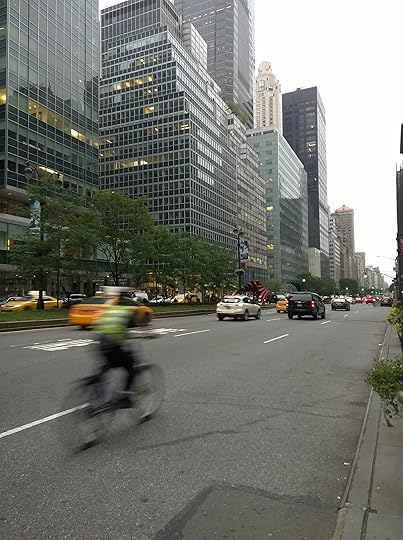 FROM THE JULY NEWS for We Said Go Travel:
FROM THE JULY NEWS for We Said Go Travel:Inspiration Writing Contest winners!
AND THE WINNERS ARE:
First Place Winner: Stephen Fabes, Don’t Look Down in Bolivia
Second Place Winner: Christina Mehriary, Marine Eyes in Iraq
Third Place Winner: Sheefa Kasar, Fulwa, India
Honorable Mentions :
Nitya Pandy: Right across the river in Nepal
Jamie Williams: Taking the Stairs in the USA
Robin Bortner: Beautiful Ugly Rome, Italy
Sasha Woffinden: The Land of the Rising Sun, Japan
Tess E. Huntington: The Journey Within Starts in Tanzania
Congratulations to the winners from the Inspiration Contest.
Thank you to everyone who participated and shared their story!
The Gratitude Travel Writing Contest will open September 11, 2015. Click here to learn more. I hope you will choose to participate.
 I loved my visit to NYC in June!
I loved my visit to NYC in June!July 2015 News from Lisa & We Said Go Travel:
I interviewed Kenny Dichter, CEO of Wheels Up in NYC. He is in my latest Wharton Business Magazine article: Putting People Into Social Media Strategy
Ask Men asked me about for dating advice from teenagers: Go on Group dates!
Group Dates
As adults, we may go out with another couple now and again, but for teens, group dating is the norm! “One thing that teens do on dates that adults should do is go out with a group. The stars are great about networking and going to parties as a group. They have a crowd and they easily meet more people. I think adults often want to go out in pairs or individually. I think adults should phone a friend and go with a group,” says Lisa Niver of WeSaidGoTravel, who worked as a set teacher on Nickelodeon’s new show, Bella and the Bulldogs .
Thank you to Cadillac, Saveur Magazine and Redbird restaurant. I enjoyed the #RoadToTable Los Angeles event and was honored to receive a social media award!
I was inspired by Rabbi Yoshi’s sermon at Stephen Wise Temple about the Three Lessons from the Grasshopper.
I sailed the night away with Harrah’s Southern California
What do you think Congress should do about the Iran Nuclear Agreement?
Thank you to Dean Nelson for sharing about 10 years of marriage equality in Canada!
Looking for travel tech gadgets? Cameryn shares five!
I am in St. Kitts this week for Restaurant week with a brand new LG G4 phone. I am enjoying testing it out. Look for great photos of my adventures on all social media: Instagram,Facebook, Twitter
I hope that your summer is full of freedom and fun.
Thank you for your support of We Said Go Travel! Lisa
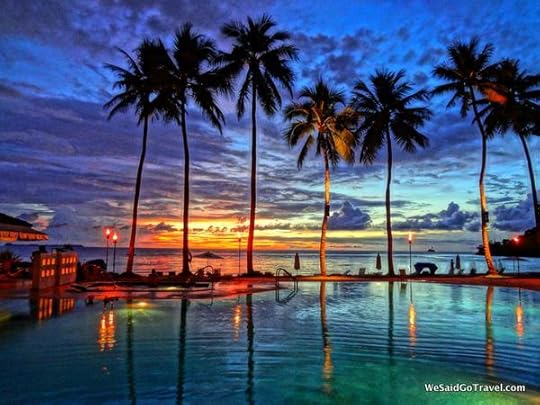 My YouTube Chanel is at 343,305 views!
My YouTube Chanel is at 343,305 views!Thank you for watching my WSGT YouTube channel which is now over 343,000+ views! Enjoy movies from Los Angeles, Bermuda, Puerto Rico, Palau, Guam, Hawaii, India as well as Bali and Lombok Indonesia, Southern Thailand, Myanmar (Burma), and Nepal. To find all 361 Videos: click here for the WSGT YouTube Channel. I am over 1000 followers on Pinterest, and up to 700+ subscribers on YouTube.
The post July 2015: Inspiration Winners & WSGT Updates appeared first on We Said Go Travel.
July 28, 2015
Lost in Amsterdam, The Netherlands
Futile – the one word which sums up efforts to impart life experience on my ears. Of course I love to listen, but until I experience the utter frustration of a foiled plan, or the crushing realization that I really should have taken that cautionary word a little more seriously, I rarely seem to learn. Nothing quite compares to the trial, error, and consequent growth that buds from the dirt of first-hand experience.
Being a teacher myself, I understand the benefits of a good one. For me, the best teachers have been Impetuous Action, Spontaneity, and Discomfort. From each of those (definitely multiple times over), I’ve learned valuable, life-long lessons that are sure to stick like graffiti – you can’t wander by and not help but notice.
Most times, I’ve learned the hard way.
So perhaps if someone would have said, “Hey, going on a roady with some guy you’d like to leave behind in the Ex’s of Past maybe isn’t the greatest idea,” on the eve of my first-ever road trip through Europe, I might have stopped and considered this for a fraction of a moment before continuing to hop on a flight that would whisk me to Belgium.
One year ago, I did indeed embark on that adventure. In my mind, it still exists as one of the most oxymoronic experiences of my life. When I think of the most serene moment of kayaking I’ve ever beheld, I think of Belgium; Belgium also happens to be the place where aforementioned not-so-significant other mashed up the side of our rented Mini Cooper and really did claim a spot in Ex’s of Past, all on the eve of our last departure to none other than: Amsterdam. While this is often remembered by most as a blur of drugs, bikes, prostitutes, and specially concocted brownies, I remember it as a blur because of how alike everything looks: each canal, each bridge, and each street.
…It’s also the city not-so-happy ex decided to abandon me in, all-the-while taking our one map with him.
At the time, I couldn’t see it, but life was about to give me one of the best lessons I could ever receive: why being lost is the most valuable human experience. Heart palpitating, palms slick against the bars of my bike, vision narrowing in while it twirled and swirled across a landscape that looks exactly the same corner after corner, bridge after bridge; everything that’s unfamiliar becomes an assault on the senses and slips that fearful seed – What if? What now? – into the forefront of your imagination. Suddenly, I was doomed to forever be lost in Amsterdam, my classes needing a new teacher, my parents having the Canadian Embassy searching for my lifeless body, and all-the-while I would be being inundated by the not-so-lucrative sex trade, made a commodity of tourism myself.
But that’s the worst-case scenario that a frantic mind pitches in moments of paranoia. Thankfully, none of that happened. Actually, a drama student attending the local university found me stopped in the street, day-dreaming with lachrymose eyes, after having just told two other discombobulated tourists that I was probably more lost than they were. Kindly, he escorted me back to the bike rental I needed to return to with about ten minutes to spare before my Visa was – yet again – vanquished by extra (and unwelcome) charges of a late rental return. With it returned my sanity and inner peace.
Being lost in Amsterdam was indeed the cornerstone to one of my best – yet most trying – lessons from the most thwarting of my three best teachers – Discomfort. The fact that I came out of that with most of my sanity (and hadn’t been delivered into Amsterdam’s finest brothel in the process) was proof enough that maybe being lost wasn’t something I should avoid in the future, but rather something to embrace. If you’ve ever survived a wrong turn, the wrong train, or even a spiteful ex hijacking a coveted map (and survived to tell the tale), then chances are there’s a lot more resilience and resourcefulness kicking around than you imagined.
Hopefully, I will find my future self lost on more occasions than I have been in the past. Being lost seems to halt your immediate attention on what’s exactly in of you, therefore dismantling distracted consideration for the future and past. I can’t dream up a better definition of living in the moment if I try.
Lesson learned? If being lost means growth – growing a little more independent, a little calmer, and a little more at peace with the unknown – then I need it. Being lost and being at peace are closely aligned, if you’ll let them be, so I’ll continue to look for those keyhole opportunities where being lost means being found.
Share your story of independence in our Independence Travel Writing Contest. Free Entry. Cash Prizes.
Finding Unexpected Joy in Turkey
I never expected to be able visit Turkey. Although everyone I knew that had been loved it, they all said how they thought it was too inaccessible for me. You see, I can’t walk much because of my disabilities, and generally use a wheelchair scooter to get around if we don’t have our car handy. I have travel with disabilities down to a science – I do my research, rent a car (or drive our own), figure it out, adjust my day. So how could I travel to Turkey, where the buildings are so ancient that accessibility isn’t really an option? I saw photos, I heard stories and travel tales, I tasted fresh Turkish delight and made gozleme. I hung evil eyes (gifts from loved ones), and read voraciously. Turkey? It was my Mt. Everest.
And then.
Turkish Airlines asked the most influential travel bloggers (including yours truly) from the White House Travel Bloggers Summit to visit Turkey. I asked if they could help make it accessible. Gizem Salcigi White of Turkish Airlines worked hard to make it so – she arranged for a wheelchair for me and found some university students, Sezer and Kadir, to help me get around Istanbul. YES!! I was so excited – I could visit a place that I dearly wanted to explore, but never thought I could. Having disabilities can be difficult, especially for travel. Venice? Probably not an option. Turkey? NOW an option!
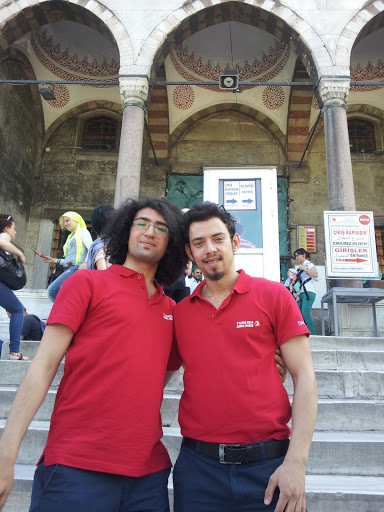
Kadir and Sezer, two university students that helped make Istanbul accessible to me.
And so I went – flying from Chicago to Istanbul was effortless. Airport handicap access is not the same the world over, but I had no issues. In fact, in Turkey, Turkish Air has these amazing trucks that lift up to the plane and then drop down and take you to the airport – all in your wheelchair. Genius.
At first, handicap accessibility was easy. I can do up to a flight of steps, so walking a few steps up into the bus that took us into Istanbul was no problem. Our hotel (the Renaissance Bosphorus) was completely accessible. I began to wonder if I had made much ado about nothing.
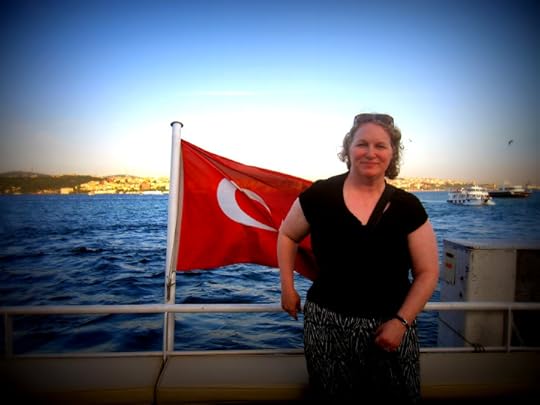
Aboard a cruise on the Bosphorus
Once in Istanbul, all of the travel writers split into groups and then went out to discover different aspects of the city. My trusty wheelchair was stowed in the back of the bus, and my university friends were ready and handy. We went to the Turkish Airlines campus, exploring training for the airline (including heading inside an enormous flight simulator), and the HUGE hangars in which airplanes are repaired. Mostly accessible, thanks to my wheelchair and Sezer and Kadir.
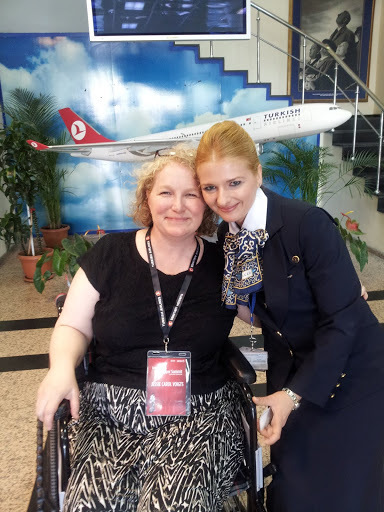
At the Turkish Airlines training center
Visiting the Blue Mosque gave me a glimpse into accessibility and ancient buildings. The wheelchair could only go so far – the rest I had to walk. I held tightly onto Kadir’s arm as I climbed the steps into the Blue Mosque, wandered around inside on the soft carpets, and then headed out again, in a daze from the beauty and history of it. Sezer had taken the chair back around to the entrance and was waiting for me.
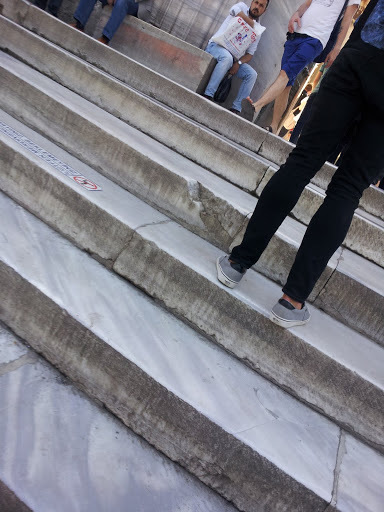
Steps into the Blue Mosque
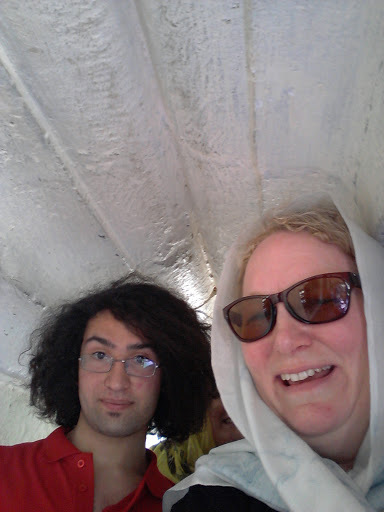
Heading into the Blue Mosque
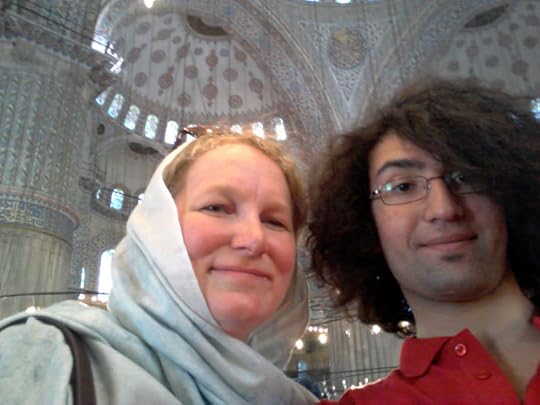
Inside the Blue Mosque with Kadir
A visit to the Hagia Sofia… same thing. You can’t really make millennia-old buildings accessible, although there are some concessions (a shorter line to get in, sort of ramps to get over the door steps). I felt a bit stymied (and in a great deal of pain), but enjoyed the time with my new friends, who pushed without complaint and sought new ways to show me parts of these gorgeous buildings. We laughed, explored, and figured it out as best we could. In the back of my mind, I was becoming more and more stressed about actually seeing anything in Istanbul. It’s too ancient, too inaccessible, too crowded.
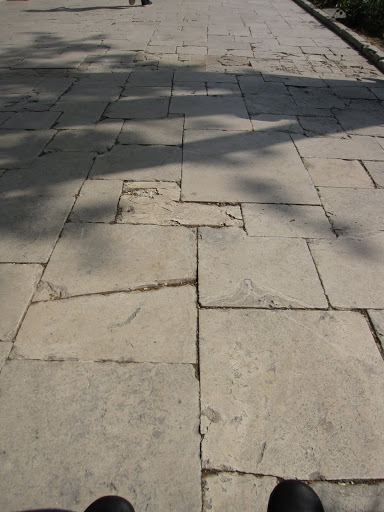
Crazy sidewalks in Istanbul – these ancient marble slates were the GOOD sidewalks!
And then it truly became more difficult. Crowds. Traffic. Steep, winding cobblestone roads. I sat in my wheelchair for a long time while my fellow travel writers went down a hill to an incredible arts museum and learned to do traditional Turkish marble painting. It was hot, and I looked at the wares for sale across the street, eyed some of the many Istanbul cats roaming the streets, people watched, and started to feel sorry for myself. It isn’t fun to wait, in the sun, while you’d rather be doing something else and you feel your disabilities acutely. Tears may or may not have entered the picture.
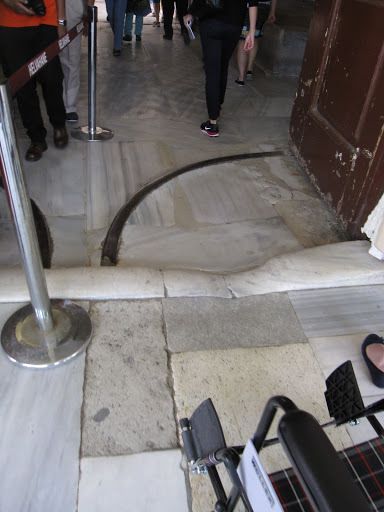
getting into ancient buildings in Istanbul.
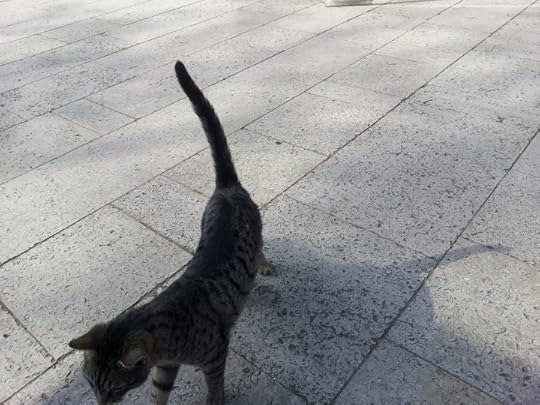
Watching cats in Istanbul
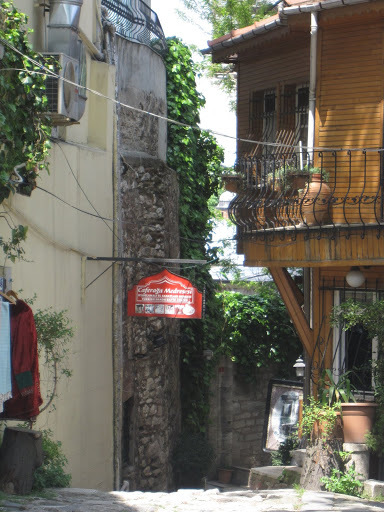
The long steep pathway to a traditional crafts museum in Istanbul – you can’t even see the door from here
And then Sezer left the museum and came up to keep me company. He showed me photos – of his friends, his beautiful mother, his home. I learned that many Istanbulites escape the city as often as they can, to go home to relax and visit family. I learned that family is extremely important in Turkish culture. I learned about what life is like for a university student in Istanbul, far from home (in Sezer’s case, beautiful Antalya). We laughed, played word games, shared stories, and sat in the sun together, enjoying each other’s company. All of a sudden, being in a wheelchair wasn’t so horrible. I was having a great time, instead of missing things I’d wanted to see and experience.
It dawned on me…that instead of seeing the sights of Istanbul (or sitting outside of the sights of Istanbul, if they were too ancient), I was here to learn about the people of Istanbul. That instead of wandering through millennia of history, I could find glimpses of now. Instead of learning about a building (i.e., Topkapi Palace – extraordinarily beautiful, but NOT accessible), I could learn about a person, family, culture. If you know me, you know I love to talk with and learn about people. Why didn’t I realize this earlier, instead of being sad about not seeing the main attractions? The change in me was immediate.
I sparked with joy.
Instead of a tour of Istanbul, I was on a people tour. Here’s how it went…
We next headed down an extremely rough cobblestone street and down a hill (one thing that Sezer and Kadir did was pretend to be Fast and Furious drivers. I didn’t fear for my life, much, but it was a great deal of fun once I got over being scared. Istanbul is hilly!). My travel writer friends headed into a beautiful pottery shop, and learned about making traditional Turkish pottery. I climbed the few steps in, and then waited while our group went downstairs to see traditional moonstone pottery. I found a newspaper with a new kind of game, like Sudoku (with famous people!), and chatted with a local. Learning about Turkish culture and talking with people? CHECK.
The next day, we visited Topkapi Palace. While some of Topkapi is somewhat accessible, most of it isn’t. For me, there was a long, restful period of time sitting around the fountain inside the grounds – peaceful and relaxing. I talked with the guys, with fellow tourists, with girls duckfacing for selfies. We then had lunch at the amazing Istanbul360, known for its views.
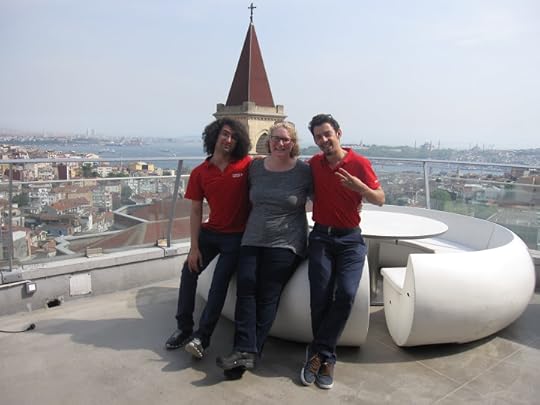
At Istanbul 360 – what a view!
Afterward, instead of heading off to explore and photograph Taksim, Galata, and other famous areas of Istanbul, Kadir and Sezer played Fast and Furious again, taking me down a very (very!) steep street (yes, some walking was involved, as the wheelchair would never have made it all the way on the street and sidewalk).
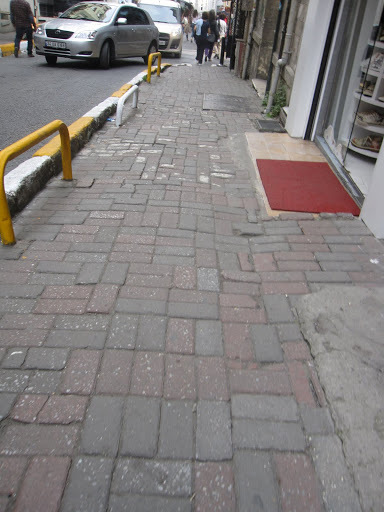
Sidewalks in Istanbul. Yes, we headed down this steep road in a wheelchair…
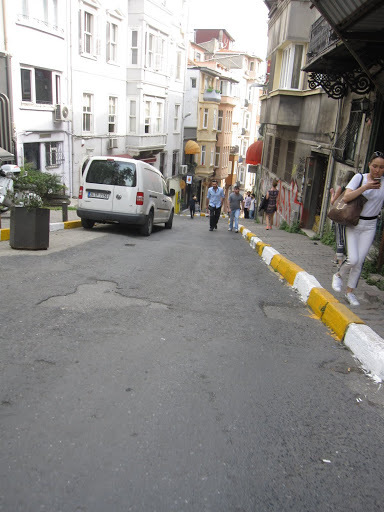
The steep road down to the lemonade cafe.
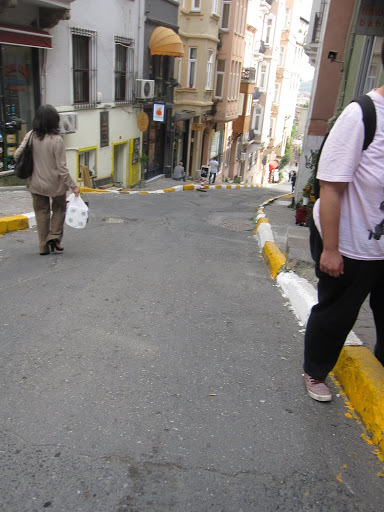
Down, down, down the hill in Istanbul
Destination? A lovely lemonade café, with a side journey to a bookstore (it’s the academic in me, I can’t pass one without going in) and an art supply store to pick up a notebook for our daughter.
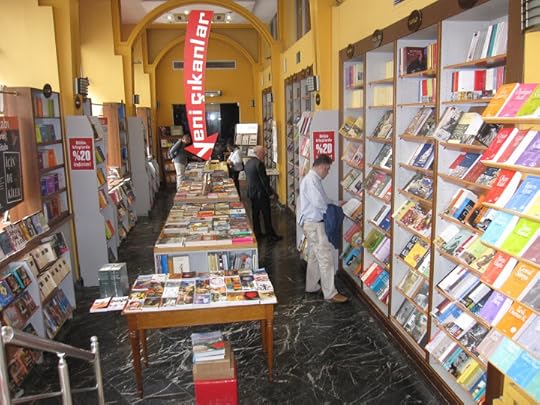
An academic can always find a bookstore or two…
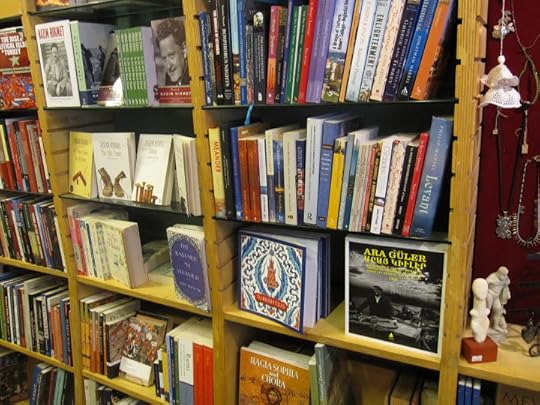
We made it to the lemonade café… and I discovered an entirely local, completely beautiful aspect of Istanbul I never knew existed. Shady trees in between the tall buildings, people playing chess, a professor holding forth to his class at the next table, couples on dates, groups of friends. THIS is also the real Istanbul, as much as the tourist attractions are. We ordered crisp, tart lemonades, and talked school mascots, friends, family, what they were studying in university, and more. We whiled away a few hours, and I thought: today, I discovered a tree in a bathroom, a secret garden, new friends with a wicked sense of humor, and a slice of life in Istanbul. It was glorious.
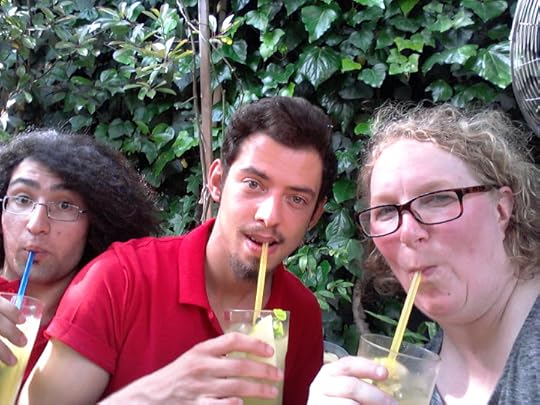
Kadir, Sezer, and I sipping lemonade
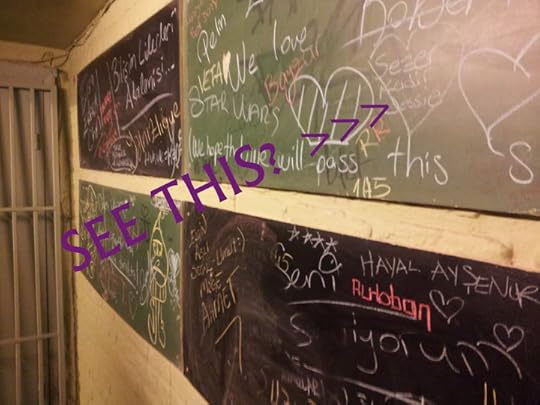
Look what message I saw on the board at the lemonade cafe in Istanbul!
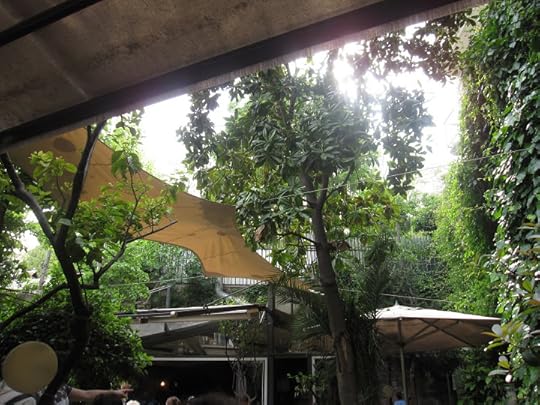
At the lemonade cafe – what an oasis of calm!
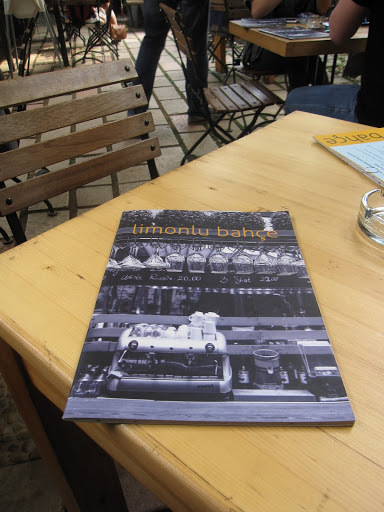
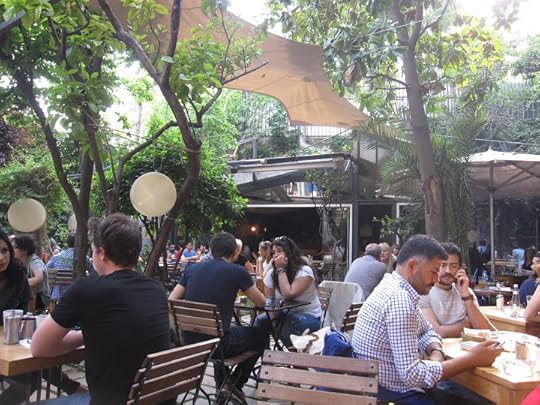
A simple change in perspective can truly change your journey.
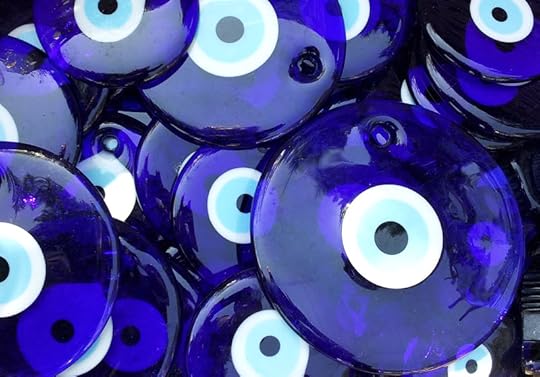
When our group went to the Spice Market, I was told that it was not accessible. Sezer and I rolled across the empty square, seeing a wedding party and a very smart way to handle the great amounts of trash in Istanbul (hint: it looks like a TARDIS). While I didn’t see the spices inside the market, I did see men on tiny stools having coffee, discussed trash with the trash guy, bought plenty of Turkish delight, discovered and discussed how many Syrian refugees are living in Istanbul, and had freshly roasted corn on the cob with Sezer, who loves old cars and showed me one of his favorites, parked near to where we munched on our corn. It was a different side of Istanbul than I’d expected to discover – one where you see real life, not just tourist stuff.
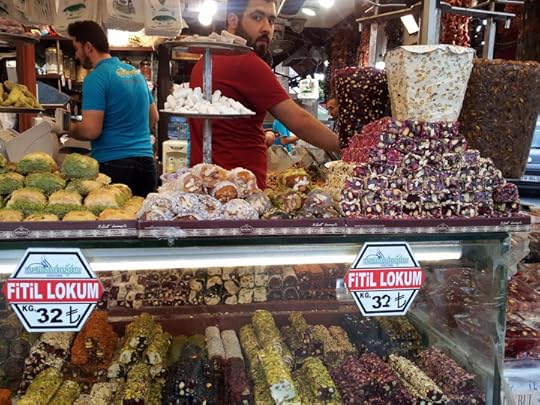
Turkish delight in Istanbul
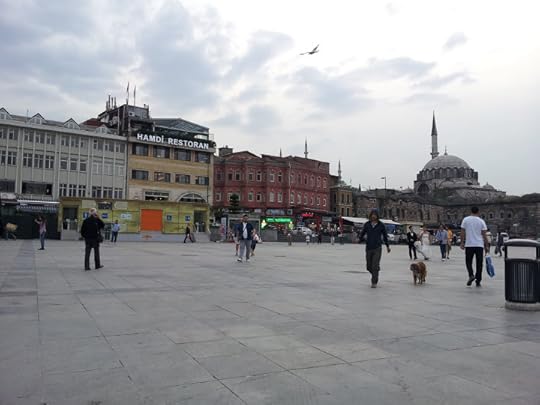
An open square near the Spice Market
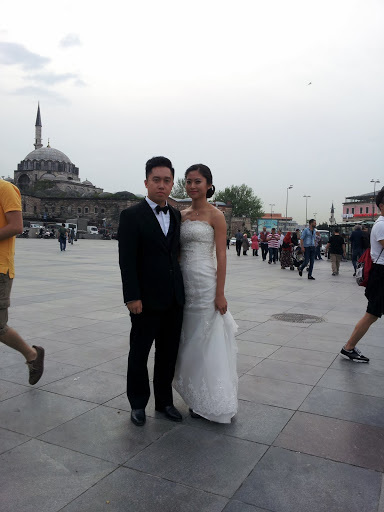
Lovely wedding couple
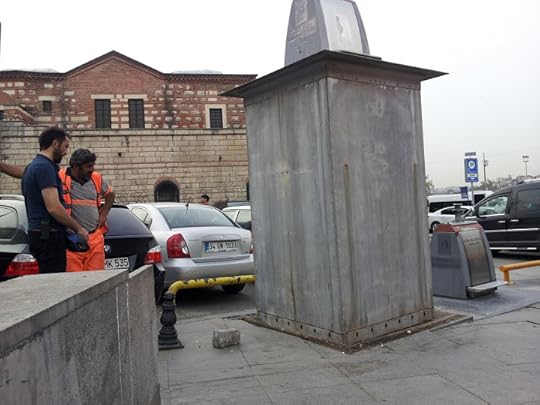
The TARDIS-like underground trash containers in Istanbul
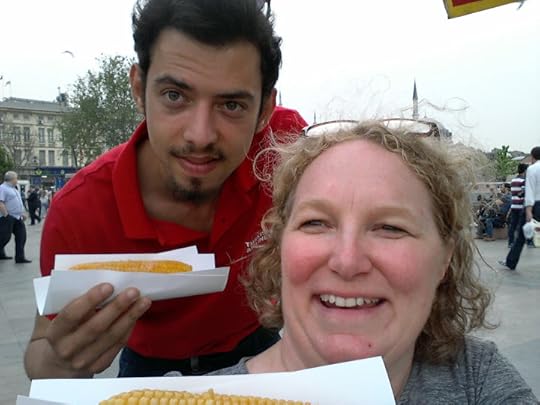
Sezer and I with fresh roasted corn
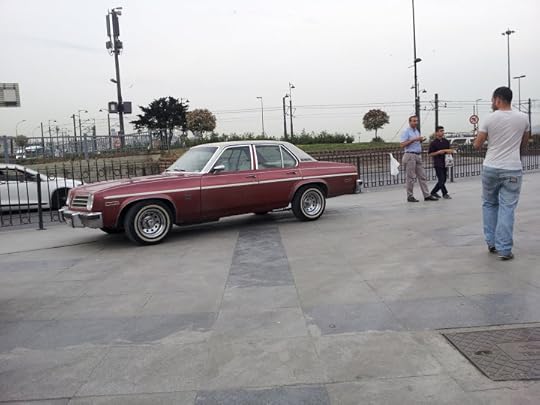
Vintage cars in Istanbul
Sezer is a cowboy, a James Dean, a renegade who will go far, but whose thoughts are never far from his home in Antalya. Kadir? He’s a sensitive, thoughtful guy, very smart and talented (he can bowl backward!), with a strong grip that helped me up many a staircase and a ready smile to encourage me.
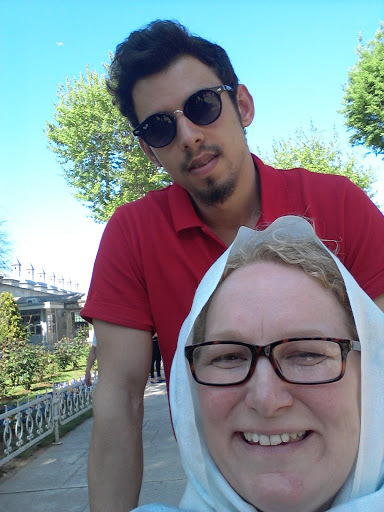
Sezer and I
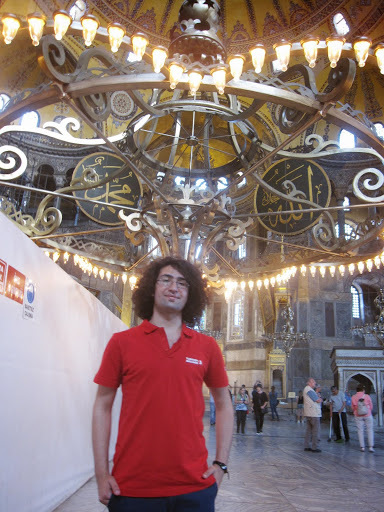
Kadir in the Hagia Sofia
My fellow travel writer friends helped when I needed it, lent arms and shoulders, and gave hugs. A loving and friendly face in a stressful situation is a wonderful thing – even better when you are longtime friends and colleagues. Like when you’re an expat and you find a box of Cheerios and your heart gives a leap? Yes. My friends made my heart happy, with their care and love.
My people tour of Turkey didn’t end in Istanbul.
When we flew to Izmir and Kusadasi, to visit Ephesus, the House of the Mother Mary, and the Basilica of St. John (and later, Pamukkale), I spent most of my waiting time with Can (pronounced John), a funny guy with a wry smile and a very caring nature. I hacked his internet while we waited atop Pamukkale (because I am addicted to Instagram and wanted to share it); laughed at signs at the marketplace at the end of visiting Ephesus; learned of his job in tourism and how he tries to help travelers with disabilities.
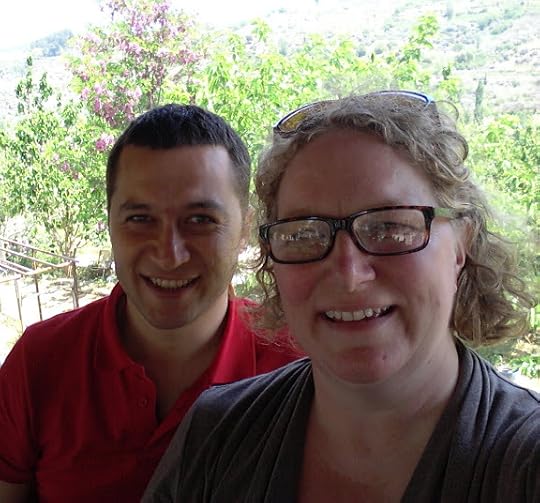
Can and I in Sirince
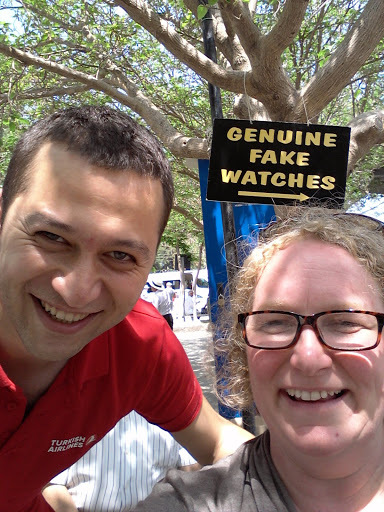
Laughing at Ephesus. No genuine fake watches were bought.
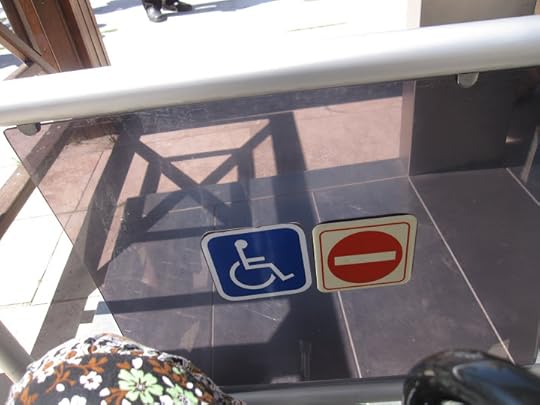
Handicap gate to Pamukkale
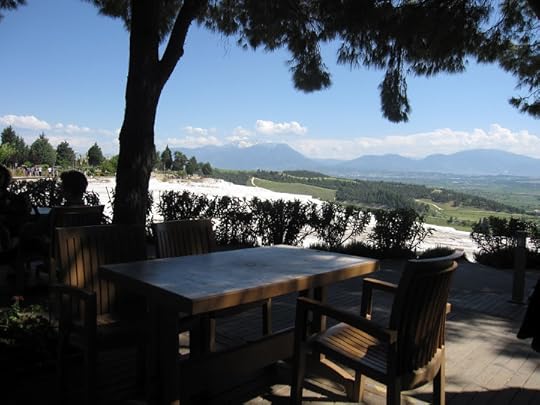
A lovely table atop Pamukkale, where we rested in the shade and instagrammed the heck out of the lovely area
When I waited outside of the ruins of the Basilica of St. John, I sat and talked with a man and his father – they ran the gift shop directly across the street. I learned that they each practice Islam very differently, but that understanding goes across generations, and is humble and kind.
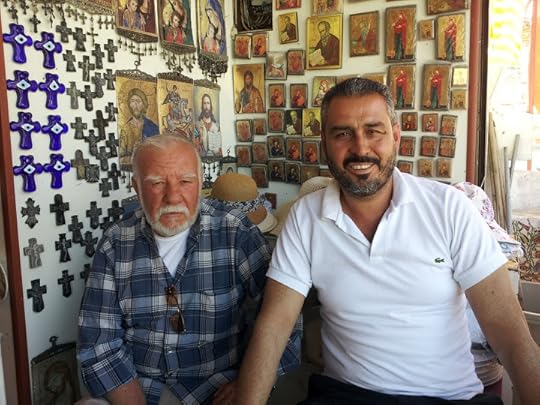
New friends
While I waited in Sirince, after a glorious lunch at Sirince Artemis, I talked with the woman who ran the beverage shop. She was surprised when I asked for a cold hot chocolate and then made me one after we figured out the language difficulties, and then she made fresh hot donuts for me (I think she wanted me to have something hot that day).
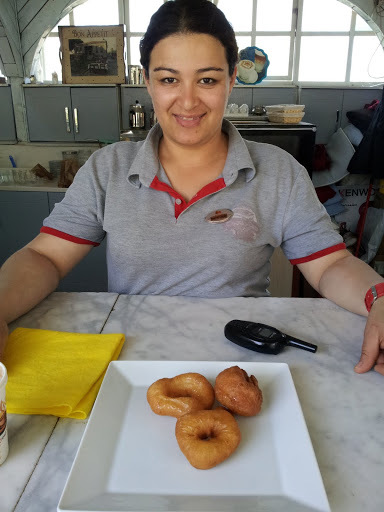
Fresh donuts for me! Thank you!
We visited a local cooperative and learned about traditional Turkish rug weaving. While our group climbed the stairs to see the amazing showroom and museum, I sat in the main weaving room under a tinted portrait of Ataturk, watching the women and girls weave in peace, chatting softly amongst themselves and showing far greater skill and talent than I had ever imagined.
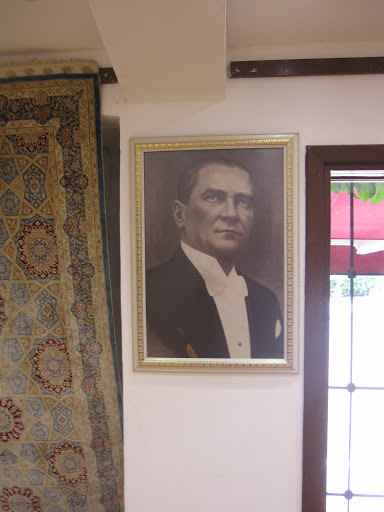
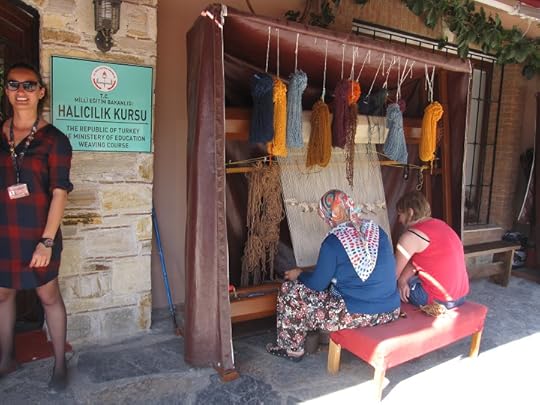
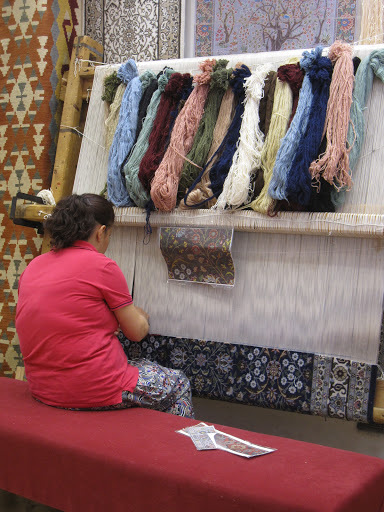
I rested and watched her artistry
When we stayed at the Hotel Kismet in Kusadasi, one of the staff very kindly took me down the hill in a golf cart, so I could swim in the Aegean as often as I could. For a mermaid such as I, this was more than welcome – it was life-giving and soul-nourishing. I know he was busy, and I appreciated his efforts.
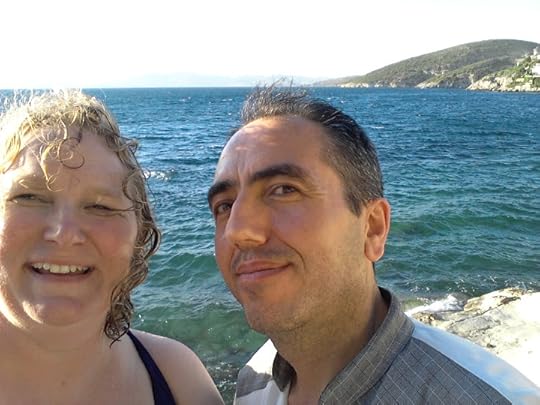
See how happy I am? BIG THANKS to this kind man for helping me to get to the sea!
When my friends boarded the Turkish Airlines flight back to Istanbul the regular way (walking across the tarmac, climbing the stairs), I talked with the guy who ran those genius accessible boarding trucks, learning about how things work at smaller airports – and who solicitously made sure I got to my seat ok.
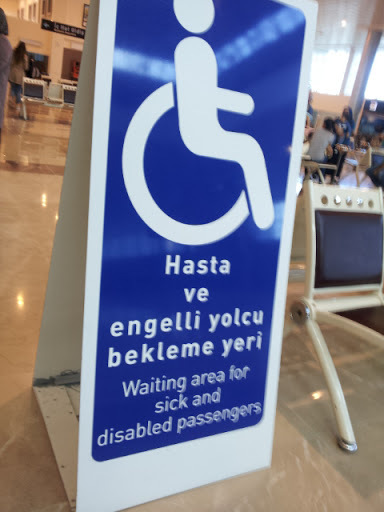
I love seeing signs like this! It means WAY less pain for me.
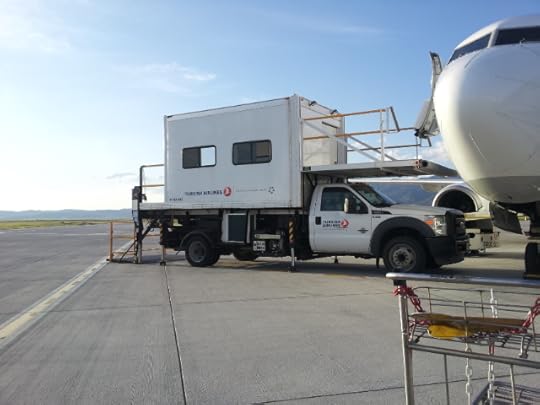
Loading truck for people with disabilities. You go on the back gate in your wheelchair, it rises up to the top. You drive to the airplane, and then get right up next to the plane. Voila – VERY accessible boarding! Thank you, Turkish Airlines.
Did I miss seeing the attractions? Yes. But I learned so much more about Turkey than I realized – about the people who live there and care about their country, who pine for their homes while they are in the city, and who daily practice kindness and generosity to strangers. While some ancient structures may be inaccessible, people with disabilities can definitely visit Turkey – if they change their mindset on how to experience place, as I did. You won’t be able to see everything, but you will be able to experience more than you ever thought possible.
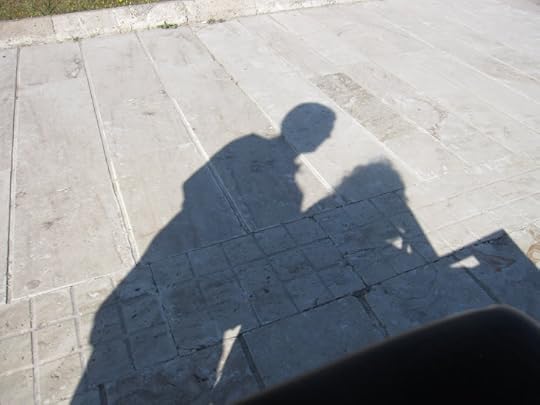
Can and I and our shadows on some pretty flat marble in Pamukkale
And the famous Turkish hospitality? It runs more deeply than I could have imagined, and made me fall in love with this venerable culture and country, which welcomed me with open arms.
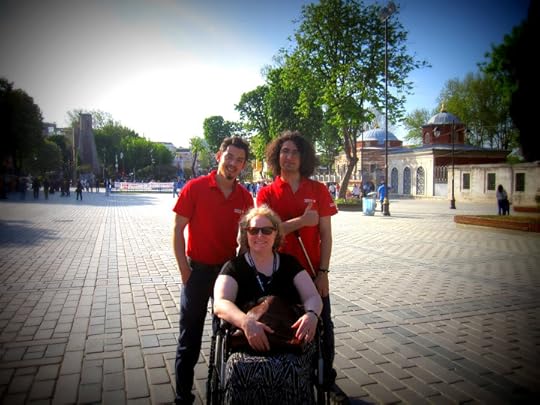
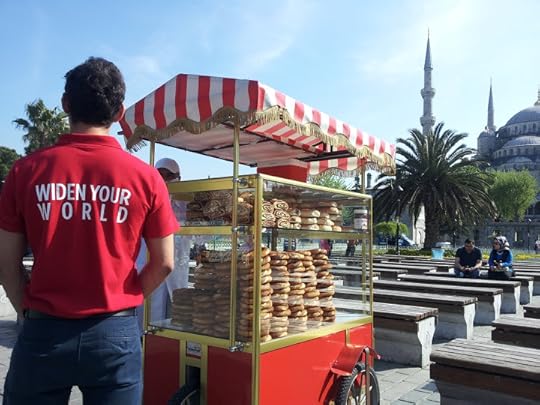
#WidenYourWorld – accessible travel in Turkey is possible!
Note: This article was originally published at Wandering Educators.
July 27, 2015
Finding Independence
“Nothing is more damaging to the adventurous spirit than a secure future.”
The powerful words of Jon Krakauer, author of Into the Wild, have wound their way into my thoughts with every crossroad I reach in recent years. Krakauer tells the compelling true story of Chris McCandless, a disaffected young graduate seeking to break with the conventions of modern life and escape the strained expectations of his parents. Tired with this existence, he cuts up his credit cards, donates all his money to charity, and sets out for a life on the road. He is never seen by his family again.
The nomadic lifestyle has always been the one I’ve wanted. I meandered towards it as a restless teenager, saving every penny for adventures near and far; now, as a university graduate, I’m hacking my way through thorns and bushes in search of the road less travelled. I’ve financed my own education, juggling three jobs while making sure I had time to explore: short bursts of adventure closer to home, as well as sublime extended trips to Eastern Europe and the Americas. Independence is my greatest asset. But it doesn’t always come easy.
***
Three months ago I was on the Peruvian side of Lake Titicaca, the highest navigable lake in the world at 3,812 metres. I watched as the sunrise leaked over the majestic Andes and into the enormous basin of water below, igniting its reflective surface. I thought about how long I’d dreamed of this; how many times I’d envisaged the tranquillity of this experience.
Many people hadn’t wanted me to be here. Parents had worried about the dangers of travelling in formerly unstable countries; concerned friends tried to persuade me that going alone as a young woman was a terrible idea. Some were entirely disinterested in the idea of travelling at all. Thankfully where much else in my life is chaotic, the compulsion to break my routine and discover new places remains steady. It’s not something everybody understands.
Tiny communities of people had already been awake for hours when we arrived on Lake Titicaca’s floating reed islands. We slid over the shiny surface of the deep water in a reed boat while women in bright traditional clothes chopped at the abundant, corn-coloured stalks, babies in slings hugged tightly to their backs.
“Life is tough here, but they fight to keep their autonomy,” the tour guide told us. “They build everything from these reeds – the islands themselves, their huts, their beds. And if they have a disagreement with a neighbour, they cut them adrift – literally.”
That night, a pendulous moon swung across the velvet night. In spite of the regularity of the process, the patterns of shadow and light reflecting off it seemed unfamiliar. As I shivered on my hilltop, I thought about the little islands of people on Lake Titicaca below, floating away from each other under an unforgiving sky. Things look different in the southern hemisphere.
***
In the end, Chris McCandless learned his most important lesson in the cruellest way possible. He had travelled extensively throughout California, weaving the fabric of his life into a rich tapestry of encounters – but mostly shunning close friendships with other travellers. Dying of starvation, alone after eating a poisonous plant in remote Alaska, a realisation dawned. He used the last of his strength to pen his final message into his journal: “happiness is only real when shared.”
Travel is to seek the answer to a question you didn’t even know you were asking, and often we have to lose ourselves to find it again. McCandless ultimately understood that his rejection of human relationships was only meaningful while he still had time to rectify it: his bold choices meant that all his happiness, as well as his suffering, had to be experienced alone.
Independence is defined just as much by the time you spend with people as without, or it can slide into isolation. A person who doesn’t know how to be alone is not exercising independence, because they still depend on external forces for fulfillment. Independence is knowing how to enjoy the soundtrack of your own thoughts alone on a night bus, but also basking in the warmth of strangers in a Peruvian desert town, feeling like you’ve known them years. It isn’t burning every bridge till you’re stranded on an island – it’s knowing when you need to get away, but also knowing when it’s time to come back.
I came back, but I’ll be gone again in time. And that is what true freedom feels like.
Thank you for reading and commenting. Please enter the Independence Travel Writing competition and tell your story.
Tempted by Tart? Sleep with the Farmer’s Daughter!
 Yes I did sleep at the Farmer’s Daughter Hotel. I did not get to swim with the ducks but I will go back to do that! I decided to taste the new tempting summer creations at Tart restaurant and Chef Keith does not disappoint. I loved the grilled trout. I highly recommend it but honestly everything was wonderful. I loved the roasted eggplant and peanut puree, roasted farmers market eggplant and heirloom cherry tomatoes. The Pepper three ways looked like a traffic light with green, yellow and red peppers. It had grilled pardons with lime and salt, pickled farmers market peppers and stuffed sweet peppers with goat cheese, avocado honey, pecans and apricot. Truly fantastic.
Yes I did sleep at the Farmer’s Daughter Hotel. I did not get to swim with the ducks but I will go back to do that! I decided to taste the new tempting summer creations at Tart restaurant and Chef Keith does not disappoint. I loved the grilled trout. I highly recommend it but honestly everything was wonderful. I loved the roasted eggplant and peanut puree, roasted farmers market eggplant and heirloom cherry tomatoes. The Pepper three ways looked like a traffic light with green, yellow and red peppers. It had grilled pardons with lime and salt, pickled farmers market peppers and stuffed sweet peppers with goat cheese, avocado honey, pecans and apricot. Truly fantastic.
I also loved the both salads I tasted: the Summer fruits salad has county line toy box melons, fresh figs, market plums, sprouts and herbs and chile lime vinaigrette and the heirloom tomato salad with gazpacho vinaigrette: shaved salted cucumbers, sourdough croutons and red watercress.
I did not save enough room for dessert but I will be back. Maybe this time I will stay in the No Tell Room! Or maybe I already did!
The Latest News ON TART!
TART Restaurant and Coolhaus Ice Cream are Mint for Each Other
TART Gets Fresh with Frozen Treats and Tantalizing Ice Cream Cocktail, Coolhaus Dirty Mint Chip Julep
LOS ANGELES – July 17, 2015 – TART — the unique, onsite restaurant nestled inside the iconic Farmer’s Daughter Hotel that serves comfort food with a twist — is celebrating summertime by collaborating with the architecturally-inspired and beloved, LA-based gourmet ice cream company, Coolhaus.
To kick off the cool-down, TART’s executive chef, Keith Shutta, has dreamed up a refreshingly naughty but n-ice cream cocktail, called the Coolhaus Dirty Mint Chip Julep ($13). Coolhaus’ fresh mint infused ice cream, chocolate chips and a hint of brown sugar make a sweet partner for the wickedly good blend of Four Roses Bourbon and Crème de Menthe, that make up this perfect treat to beat the summer heat.
TART’s summer dessert menu has two other delicious new recruits: Coolhaus’ Chocolate Chip Ice Cream Sandwich ($8) and the Snickerdoodle Ice Cream Sandwich ($8).
“Adding Coolhaus to the menu and creating a cocktail with its all-natural ice cream is something no one else has done before and we know our guests love those unique experiences,” said Keith Shutta, TART’s executive chef. “Partnering with a local and loved business that also uses locally farmed and sourced goods is the perfect match for TART,” added Shutta.
“This partnership is a meeting of the minds, and taste buds. Coolhaus and TART both blend unusual flavors that develop into famous favorites, and I know that the Coolhaus Dirty Mint Chip Julep will become another local celebrity,” added Natasha Case, CEO and co-founder of Coolhaus.
Coolhaus’ ice cream sandwiches and the Coolhaus Dirty Mint Chip Julep are available at TART now, for a limited time. TART is located at 115 S. Fairfax Avenue, Los Angeles, CA 90036. For reservations, call (323) 556-2608 or visit: http://tartrestaurant.com/
A photo posted by Lisa Niver (@wesaidgotravel) on Jul 20, 2015 at 8:38pm PDT
Chef Keith’s summer treats are waiting for you @tartrestaurant. Try the Summer fruits salad: with county line toy box melons, fresh figs, market plums, sprouts and herbs and chile lime vinaigrette. I loved the heirloom tomato salad with gazpacho vinaigrette: shaved salted cucumbers, sourdough croutons and red watercress. Stay @farmersdaughterhotel and test out the no tell room! Spicy! #farmersdaughterhotel #tartrestaurant A photo posted by Lisa Niver (@wesaidgotravel) on Jul 20, 2015 at 8:46pm PDT
VIDEO: The Farmer’s Daughter and Tart Restaurant
We Said Go Travel
We Said Go Travel is a global community of over sixteen hundred writers with articles from every continent.
Stories are shared with photos and video from a perspective of the transformative power of travel. We Said Go Travel has hosted live and online events as well as travel writing contests around the world. ...more
- Lisa Niver's profile
- 57 followers



